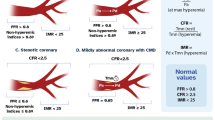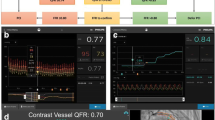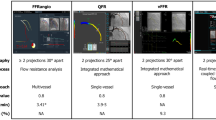Abstract
Visual coronary angiography stenosis severity poorly predicts the physiological significance of the stenosis. In patients with coronary artery disease, the presence of inducible myocardial ischemia is an important risk factor for an adverse clinical outcome and can be used to risk-stratify patients. As recommended by current guidelines for the treatment of coronary artery disease, the presence of myocardial ischemia should play a pivotal role in the decision-making process about coronary revascularization. There are hyperemic and non-hyperemic pressure indices to determine the physiological significance of the stenosis. In this chapter, we will discuss the hyperemic index—Fractional flow reserve [FFR]; one of the many but most commonly used non-hyperemic index—Instantaneous wave-free ratio [iFR] along with a brief description of non-invasive approach using CT-FFR.
Access this chapter
Tax calculation will be finalised at checkout
Purchases are for personal use only
Similar content being viewed by others
References
Van de Hoef TP, van Lavieren MA, Damman P, Delewi R, Piek MA, Chamuleau SA, Voskuil M, Henriques JP, Koch KT, de Winter RJ, Spaan JA. Physiological basis and long-term clinical outcome of discordance between fractional flow reserve and coronary flow velocity reserve in coronary stenoses of intermediate severity. Circ Cardiovasc Interv. 2014 Jun;7(3):301–11.
Tonino PA, De Bruyne B, Pijls NH. Fractional flow reserve versus angiography for guiding percutaneous coronary intervention. N Engl J Med. 2009;360(3):213–24.
De Bruyne B, Pijls NH, Kalesan B. Fractional flow reserve-guided PCI versus medical therapy in stable coronary disease. N Engl J Med. 2012;367(11):991–1001.
Nijjer SS, Sen S, Petraco R, Mayet J, Francis DP, Davies JE. The Instantaneous wave-Free Ratio (iFR) pullback: a novel innovation using baseline physiology to optimise coronary angioplasty in tandem lesions. Cardiovasc Revasc Med. 2015 Apr 1;16(3):167–71.
Conte E, Sonck J, Mushtaq S, Collet C, Mizukami T, Barbato E, Tanzilli A, Nicoli F, De Bruyne B, Andreini D. FFRCT and CT perfusion: a review on the evaluation of functional impact of coronary artery stenosis by cardiac CT. Int J Cardiol. 2020 Feb 1;300:289–96.
Author information
Authors and Affiliations
Corresponding author
Editor information
Editors and Affiliations
Rights and permissions
Copyright information
© 2021 Springer Nature Switzerland AG
About this chapter
Cite this chapter
Jain, T., Kini, A. (2021). Physiological Assessment During Interventional Procedures. In: Kini, A., Sharma, S.K. (eds) Practical Manual of Interventional Cardiology. Springer, Cham. https://doi.org/10.1007/978-3-030-68538-6_4
Download citation
DOI: https://doi.org/10.1007/978-3-030-68538-6_4
Published:
Publisher Name: Springer, Cham
Print ISBN: 978-3-030-68537-9
Online ISBN: 978-3-030-68538-6
eBook Packages: MedicineMedicine (R0)




